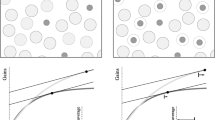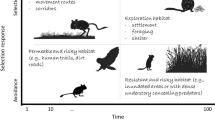Abstract
We have developed a habitat selection model based on central place foraging theory. An individual’s decision to include a patch in its habitat depends on the marginal fitness contribution of that patch, which is characterized by its quality and distance to the central place. The essence of the model we have developed is a fitness isocline which is a function of patch quality and travel time to the patch. It has two parameters: the maximum travel distance to a patch of infinite quality and a coefficient that appropriately scales quality by travel time. Patches falling below the isocline will have positive marginal fitness values and should be included in the habitat. The maximum travel distance depends on the availability and quality of patches, as well as on the forager’s life history, whereas the scaling parameter mostly depends on life history properties. Using the model, we derived a landscape quality metric (which can be thought of as a connectivity measure) that sums the values of available habitat in the landscape around a central place. We then fitted the two parameters to foraging data on breeding white storks (Ciconia ciconia) and estimated landscape quality, which correlated strongly with reproductive success. Landscape quality was then calculated for a larger region where re-introduction of the species is currently going on in order to demonstrate how this model can also be regarded as a species distribution model. In conclusion, we have built a general habitat selection model for central place foragers and a novel way of estimating landscape quality based on a behaviorally scaled connectivity metric.






Similar content being viewed by others
References
Austin M (2007) Species distribution models and ecological theory: a critical assessment and some possible new approaches. Ecol Model 200:1–19
Bates D, Maechler M (2010) lme4: linear mixed-effects models using S4 classes. Available at: http://cran.r-project.org/web/packages/lme4/index.html
Beier P, Spencer W, Baldwin RF, McRae BH (2011) Toward best practices for developing regional connectivity maps. Conserv Biol 25:879–892
Bogetoft P, Otto L (2011) Benchmarking with DEA, SFA, and R. Springer, New York
Bozinovic E, Vásquez RA (1999) Patch use in a diurnal rodent: handling and searching under thermoregulatory costs. Funct Ecol 13:602–610
Brown JS (1988) Patch use as an indicator of habitat preference, predation risk, and competition. Behav Ecol Sociobiol 22:37–47
Buchholz R (2007) Behavioural biology: an effective and relevant conservation tool. Trends Ecol Evol 22:401–407
Burke CM, Montevecchi WA (2009) The foraging decisions of a central place foraging seabird in response to fluctuations in local prey conditions. J Zool 278:354–361
Cabral JS, Kreft H (2012) Linking ecological niche, community ecology and biogeography: insights from a mechanistic niche model. J Biogeogr 39:2212–2224
Calabrese JM, Fagan WF (2004) A comparison-shopper’s guide to connectivity metrics. Front Ecol Environ 2:529–536
Carrascal LM, Alonso JC, Alonso JA (1990) Aggregation size and foraging behavior of White Storks Ciconia ciconia during the breeding season. Ardea 78:399–404
Carrascal LM, Bautista LM, Lazaro E (1993) Geographical variation in the density of the white stork Ciconia ciconia in Spain—influence of habitat structure and climate. Biol Conserv 65:83–87
Carvell C, Jordan WC, Bourke AFG, Pickles R, Redhead JW, Heard MS (2012) Molecular and spatial analyses reveal links between colony-specific foraging distance and landscape-level resource availability in two bumblebee species. Oikos 121:734–742
Chivers LS, Lundy MG, Colhoun K, Newton SF, Houghton JDR, Reid N (2012) Foraging trip time-activity budgets and reproductive success in the black-legged kittiwake. Mar Ecol Prog Ser 456:269–277
Cresswell JE, Osborne JL, Goulson D (2000) An economic model of th limits to foraging range in central place foragers with numerical solutions for bumblebees. Ecol Entomol 25:249–255
Cuthill IC, Kacelnik A (1990) Central place foraging: a reappraisal of the ‘loading effect’. Anim Behav 40:1087–1101
Dancose K, Fortin D, Guo XL (2011) Mechanisms of functional connectivity: the case of free-ranging bison in a forest landscape. Ecol Appl 21:1871–1885
Dormann CF, Schymanski SJ, Cabral J, Chuine I, Graham C, Hartig F et al (2012) Correlation and process in species distribution models: bridging a dichotomy. J Biogeogr 39:2119–2131
Dziewiaty K (1992) Nahrungsokologische Untersuchungen am Weissstorch Ciconia ciconia in der Dannenberger Elbmarsch (Niedersachsen). Vogelwelt 113:133–144
Dziewiaty K (2002) Significance of the Elbe dyke foreshore and hinterland as feeding habitats for white storks (Ciconia ciconia). Vogelwarte 41:221–230
Goulson D (2003) Bumblebees: their behaviour and ecology. Oxford University Press, Oxford
Hanski I (2000) Metapopulation ecology. Oxford University Press, Oxford
Higgins SI, O’Hara RB, Römermann C (2012) A niche for biology in species distribution models. J Biogeogr 39:2091–2095
Jha S, Kremen C (2013) Resource diversity and landscape-level homogeneity drive native bee foraging. Proc Natl Acad Sci USA 110:555–558
Johst K, Brandl R, Pfeifer R (2001) Foraging in a patchy and dynamic landscape: human land use and the White Stork. Ecol Appl 11:60–69
Kadoya T (2009) Assessing functional connectivity using empirical data. Popul Ecol 51:5–15
Knight ME et al (2005) An interspecific comparison of foraging range and nest density of four bumblebee (Bombus) species. Mol Ecol 14:1811–1820
Koenker R (2013) Quantile regression in R: A vignette. http://cran.rproject.org
Kotler BP, Brown JS, Knight MH (1999) Habitat and patch use by hyraxes: there’s no place like home? Ecol Lett 2:82–88
Kramer DL, Nowell W (1980) Central place foraging in the eastern chipmunk Tamias striatus. Anim Behav 28:772–778
Lonsdorf E, Kremen C, Ricketts TH, Winfree R, Williams NM, Greenleaf SS (2009) Modelling pollination services across agricultural landscapes. Ann Bot 103:1589–1600
MacArthur RH, Pianka ER (1966) On optimal use of a patchy environment. Am Nat 100:603–609
Mitchell MS, Powell RA (2007) Optimal use of resources structures home ranges and spatial distribution of black bears. Anim Behav 74:219–230
Moilanen A, Hanski I (2001) On the use of connectivity measures in spatial ecology. Oikos 95:147–151
Moritzi M, Maumary L, Schmid D, Steiner I, Vallotton L, Spaar R, Biber O (2001) Time budget, habitat use and breeding success of White Storks Ciconia ciconia under variable foraging conditions during the breeding season in Switzerland. Ardea 89:457–470
Olsson O (2007) Genetic origin and success of reintroduced white storks. Conserv Biol 21:1196–1206
Olsson O, Molokwu MN (2007) On the missed opportunity cost, GUD, and estimating environmental quality. Isr J Ecol Evol 53:263–278
Olsson O, Rogers DJ (2009) Predicting the distribution of a suitable habitat for the white stork in Southern Sweden: identifying priority areas for reintroduction and habitat restoration. Anim Conserv 12:62–70
Olsson O, Brown JS, Smith HG (2001) Gain curves in depletable food patches: a test of five models with European starlings. Evol Ecol Res 3:285–310
Olsson O, Brown JS, Helf KL (2008) A guide to central place effects in foraging. Theor Popul Biol 74:22–33
Ovaskainen O, Hanski I (2001) Spatially structured metapopulation models: global and local assessment of metapopulation capacity. Theor Popul Biol 60:281–302
Pulliam HR (2000) On the relationship between niche and distribution. Ecol Lett 3:349–361
R Development Core Team (2012) R: a language and environment for statistical computing. R Foundation for Statistical Computing, Vienna
Rainho A, Palmeirim JM (2011) The importance of distance to resources in the spatial modelling of bat foraging habitat. PLoS One 6:e19227
Schaub M, Pradel R, Lebreton JD (2004) Is the reintroduced white stork (Ciconia ciconia) population in Switzerland self-sustainable? Biol Conserv 119:105–114
Schoener TW (1979) Generality of size–distance relation in model of optimal feeding. Am Nat 114:902–914
Stephens DW, Brown JS, Ydenberg RC (2007) Foraging. Behavior and ecology. The University of Chicago Press, Chicago
Tinbergen JM (1981) Foraging decisions in starlings (Sturnus vulgaris L.). Ardea 69:1–76
Tischendorf L, Fahrig L (2000) On the usage and measurement of landscape connectivity. Oikos 90:7–19
Tryjanowski P, Sparks TH, Profus P (2005) Uphill shifts in the distribution of the white stork Ciconia ciconia in southern Poland: the importance of nest quality. Divers Distrib 11:219–223
van der Have TM, Enters A, Harte M, Jonkers DA, van Nee W, Reitveld R (1999) The return of the white stork in the Netherlands: population size and breeding success in 1995. In: Schulz H (ed) Proc Int Symp on white stork.. NABU (Naturschutzbund Deutschland e.V.), Bonn, pp 103–110
van Gils JA, Tijsen W (2007) Short-term foraging costs and long-term fueling rates in central-place foraging swans revealed by giving-up exploitation times. Am Nat 169:609–620
von Post M, Borgstrom P, Smith HG, Olsson O (2012) Assessing habitat quality of farm-dwelling house sparrows in different agricultural landscapes. Oecologia 168:959–966
Westphal C, Steffan-Dewenter I, Tscharntke T (2006) Bumblebees experience landscapes at different spatial scales: possible implications for coexistence. Oecologia 149:289–300
Wiktander U, Olsson O, Nilsson SG (2001) Seasonal variation in home-range size, and habitat area requirement of the lesser spotted woodpecker (Dendrocopos minor) in south Sweden. Biol Conserv 100:387–395
Williams NM, Regetz J, Kremen C (2012) Landscape-scale resources promote colony growth but not reproductive performance of bumble bees. Ecol 93:1049–1058
Winfree R et al (2005) Testing simple indices of habitat proximity. Am Nat 165:707–717
Ydenberg RC, Davies WE (2010) Resource geometry and provisioning routines. Behav Ecol 21:1170–1178
Zurbuchen A, Cheesman S, Klaiber J, Müller A, Hein S, Dorn S (2010) Long foraging distances impose high costs on offspring production in solitary bees. J Anim Ecol 79:674–681
Acknowledgments
This study was financed through Grants from Formas, Oscar and Lili Lamms Stiftelse, and the Centre for Environment and Climate research at Lund University to OO and through the Formas-funded project SAPES. We thank Alan Brelsford, Daniel Rogers and Nina Yoo Pedersen for assistance in the field, and Eric Lonsdorf, Geerten Hengeveld, Jan van Gils, Chris Whelan and two anonymous referees for valuable comments on previous versions of the manuscript.
Author information
Authors and Affiliations
Corresponding author
Additional information
Communicated by Chris Whelan.
Electronic supplementary material
Below is the link to the electronic supplementary material.
Rights and permissions
About this article
Cite this article
Olsson, O., Bolin, A. A model for habitat selection and species distribution derived from central place foraging theory. Oecologia 175, 537–548 (2014). https://doi.org/10.1007/s00442-014-2931-9
Received:
Accepted:
Published:
Issue Date:
DOI: https://doi.org/10.1007/s00442-014-2931-9




